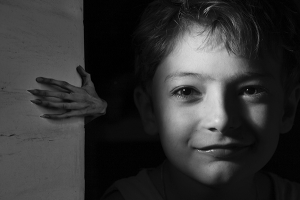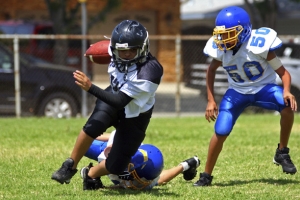
If you’ve ever left the house with a child wearing a super hero cape or princess dress, or if you’ve ever noticed your daughter’s socks don’t match as you’re dropping her at school or realized your son’s shirt was on backwards at the end of the day, you know the challenges of dressing kids. Whether it’s a matter of clothes not matching or getting your child to bundle up in cold weather, handling wardrobe issues can be sticky. Here’s some advice from moms and experts on how to approach some common childhood “clothing conundrums:”
Mismatched Clothes or Socks
Blame Little Miss Mismatch for the popularity of odd clothing combinations all you like, there’s still the issue of what to do when your child tries to leave the house in plaids and stripes.
Shari Braendel, fashion expert and author of “Good Girls Don’t Have to Dress Bad,” suggests leaving well enough alone. “This is their way of showing individuality. They’re experimenting with their creativity. It may be an attention-getting thing, but it won’t be attention-getting for long.” Braendel goes on to emphasize as long as it doesn’t hurt them, there’s no reason to intervene.
Multiple Wardrobe Changes
Kids may go through periods of time where they change what they wear multiple times during the day. It might not seem to be a big deal to anyone but the person who does the laundry. Or it can become a big deal if it prevents them from getting out the door on time. Aside from taking all their clothes away (which may work as a last resort), what’s a parent to do?
“Sometimes too much choice can be overwhelming,” says psychologist Dr. Bobbie McDonald. “What I suggest, rather than giving them a completely open choice, or none at all, is to choose two or three outfits and say, ‘It’s cold outside. Here are three outfit choices, or you can mix and match. So which outfit would you like?”
Colleen Sall, mother of two elementary-aged children, found a solution in selecting clothes the night before. “The biggest problem was there hadn’t been any planning in advance to make sure they had everything they wanted to wear to get out the door to school. So there were a lot of last-minute changes going on. That was a problem because everything looked okay and then all of a sudden they’d put on a sock and it had a hole.”
Now her children lay out their outfits before they go to bed. They talk about what activities will be happening and what the weather forecaster calls for the next day.
“I give a range of what the temperature is going to be like. They may ask for clarification like, ‘Do I need a coat?’ My daughter doesn’t feel like she’s being bossed around with what to wear. She feels like she’s getting some pretty solid advice. The best part is that it’s become so automatic.”
Clothes that Don’t “Feel” Right
Some children have tactile sensitivities that make it hard for them to feel comfortable in certain clothes. The seam on the end of the socks may irritate them, or the way a pair of pants rides on their hips. These sensitivities can make it difficult for parents to get them dressed and out the door. But there are ways to overcome this.
“Those are real issues,” says Dr. McDonald. “A lot of times parents view that as their child being stubborn or rigid. Everybody is different.”
Dr. McDonald recommends taking the child along to try on clothes before buying them. “They can get a sense of does it feel itchy and scratchy or soft and comfortable. It can really help when it comes time for that child to wear those clothes. Too often what happens is, parents want to buy the clothes, bring them home and the kid should like it. They set themselves up for failure.”
Battles Over Clothing Choices
When children are very young, they often have little opinion on what clothes they like. Sometimes they may have a favorite shirt or dress, but otherwise they wear whatever mom buys. But as children get older and begin to assert their independence there may be a clash of opinions on what clothes are best.
This issue happens most often at the clothing store while shopping for clothes. A parent may be used to picking out all the clothes they buy for their child. And one day that child begins to balk at mom’s selections. In turn, parents may object to clothes kids pick due to issues of appropriateness or revealing styles for girls.
“It’s a struggle for parents on the whole because a lot of times when a style is ‘in’ it’s tighter fitting, lower cut. You don’t want your kids dressing abnormally. You want them to fit in. But when you have different values of how you want them to dress and the current style does not follow those, it’s very frustrating,” says Melanie Wozniak, mom to three girls and one boy.
Wozniak says when her children ask to buy something she doesn’t care for she redirects them. “I tell them, ‘let’s go look at something else. Let’s find something cuter.’”
Braendel suggests preparing before a shopping trip by discussing what they can and can’t wear. Make it clear what clothes you’ll allow. “Agree together ahead of time what the guidelines will be. Then instead of saying ‘you cannot wear this’, tell them what they can wear. Give them really positive things to look for when they shop instead of negative advice.”
Braendel notes an important concept when it comes to clothing issues and our children’s appearance. “What they put on is a reflection of who they are on the inside. We need to understand our child is not a reflection of us. We think they are. So we’re the ones who get embarrassed. We just have to get over that.”
Dr. McDonald agrees. “It’s important to step past our own ego of what they should look like and let them have that freedom of expression. Because when we give that to them, it gives them a sense of self-confidence and self-empowerment.”
-------------------------
Lara Krupicka is a freelance writer and mom to three girls who have very different clothing tastes from hers.
Published: March 2012



















